A Low-Cost Open-Source Architecture for a Digital Signage Emergency Evacuation System for Cruise Ships, Based on IoT and LTE/4G Technologies
Abstract
1. Introduction
Health Hazards and Safety Risks during Evacuations
2. Related Work
3. Digital Signage Systems’ Design and IoT Technologies Comparison
3.1. Comparison of IoT Technologies
3.1.1. Personal Area Network (PAN)
3.1.2. Local Area Network (LAN)
3.1.3. Low Power Wide Area Network (LPWAN)
3.1.4. Satellite Communications
3.1.5. Wide Area Networks (WAN)
3.2. Comparison of IoT Protocols
3.2.1. Message Queue Telemetry Transport (MQTT) Protocol
3.2.2. HyperText Transfer Protocol (HTTP)
3.3. Features and Evaluation of MQTT protocol in LTE/4G Communications
4. Low-Cost Experimental Implementation Using on-Premises LTE/4G Network
4.1. Experimental Implementation
4.2. Digital Signage Scalability
5. Conclusions—Future Work
Author Contributions
Funding
Data Availability Statement
Conflicts of Interest
References
- Roland Petrasch. Roman Hentschke, Process Modelling for Industry 4.0 Applications. In Proceedings of the 13th International Joint Conference on Computer Science and Software Engineering (JCSSE), Khon Kaen, Thailand, 13–15 July 2016. [Google Scholar]
- MSC/Circ. 909; Guidelines for a Simplified Evacuation Analysis for New and Existing Passenger Ships. International Maritime Organization: London, UK, 1999; p. 3.
- MSC/Circ. 1033; Guidelines for a Simplified Evacuation Analysis for New and Existing Passenger Ships. International Maritime Organization: London, UK, 2003; p. 4.
- MSC/Circ. 1238; Guidelines for a Simplified Evacuation Analysis for New and Existing Passenger Ships. International Maritime Organization: London, UK, 2007; p. 4.
- MSC/Circ. 1533; Guidelines for a Simplified Evacuation Analysis for New and Existing Passenger Ships. International Maritime Organization: London, UK, 2016; p. 4.
- Nasso, C.; Bertagna, S.; Mauro, F.; Marino, A.; Bucci, V. Simplified and Advanced Approaches for Evacuation Analysis of Passenger Ships in the Early Stage of Design; Brodogradnja: Zagreb, Croatia, 2019; pp. 44–48. [Google Scholar]
- Hongxu, C.; Huan, L.; HaiBo, Z.; Lin, W.Y. Simulation Analysis of Urban Rail Transit Station Evacuation Considering Line of Sight Obstruction. In Proceedings of the 5th International Conference on Information Science, Computer Technology and Transportation (ISCTT), Shenyang, China, 13–15 November 2020; p. 1. [Google Scholar]
- Wang, H.; Jiang, Z.; Xu, T.; Li, F. A Quantitative Approach of Subway Station Passengers’ Heterogeneity of Decision Preference Considering Personality Traits during Emergency Evacuation. Sustainability 2021, 13, 12540. [Google Scholar] [CrossRef]
- Mahmood, I.; Haris, M.; Sarjoughian, H. Analysing Emergency Evacuation Strategies for Mass Gatherings using Crowd Simulation and Analysis framework: Hajj Scenario. In Proceedings of the 2017 ACM SIGSIM Conference, Singapore, 24–26 May 2017. [Google Scholar] [CrossRef]
- Ping, P.; Wang, K.; Kong, D. Analysis of emergency evacuation in an offshore platform using evacuation simulation modeling. Phys. A Stat. Mech. Its Appl. 2018, 505, 601–612. [Google Scholar] [CrossRef]
- Lee, J.W.; Kim, Y.W. A Study on Smart IoT Hub for Intelligent Signage Services Using Trust Information. In Proceedings of the International Conference on Information Networking, Chiang Mai, Thailand, 10–12 January 2018; pp. 1–3. [Google Scholar]
- Lee, S.; Shin, I.; Lee, N. Development of IoT based Smart Signage Platform. In Proceedings of the 2018 International Conference on Information and Communication Technology Convergence (ICTC), Jeju, Republic of Korea, 17–19 October 2018; IEEE: Piscataway, NJ, USA, 2018; pp. 1–3. [Google Scholar]
- Zualkernan, I.A.; Al Noman, H.; Aloul, F.A.; Sowdagar, S. An IoT-based Emergency Evaquation System. In Proceedings of the International Conference on Internet of Things and Intelligence System, Bali, Indonesia, 5–7 November 2019; pp. 1–3. [Google Scholar]
- Hsu, H.P.; Yu, K.M.; Chine, S.T.; Cheng, S.T.; Lei, M.Y.; Tsai, N. Emergency Evacuation Base on Intelligent Digital Signage Systems. In Proceedings of the 7th International Conference on Ubi-Media Computing and Workshops, Ulaanbaatar, Mongolia, 12–14 July 2014. [Google Scholar] [CrossRef]
- Novelli, L.; Jorge, L.; Melo, P.; Koscianski, A. Application Protocols and Wireless Communication for IoT: A Simulation Case Study Proposal. In Proceedings of the 11th International Symposium on Communication Systems, Networks & Digital Signal Processing, Budapest, Hungary, 18–20 July 2018. [Google Scholar] [CrossRef]
- Azzi, A.; Pennycott, A.; Mermiris, G.; Vassalos, D. Evacuation Simulation of Shipboard Fire Scenarios, Baltimore. 2021, p. 4. Available online: https://files.thunderheadeng.com/femtc/2011_d2-16-azzi-paper.pdf (accessed on 6 November 2022).
- TUI, MARELLA EXPLORER. Available online: https://www.tui.co.uk/cruise/ships/marella-explorer/ (accessed on 11 January 2022).
- Hu, M.; Cai, W. Research on the Evacuation Characteristics of Cruise Ship Passengers in Multi-Scenarios. Appl. Sci. 2022, 12, 4213. [Google Scholar] [CrossRef]
- Peladarinos, N.; Cheimaras, V.; Piromalis, D.; Arvanitis, K.G.; Papageorgas, P.; Monios, N.; Dogas, I.; Stojmenovic, M.; Tsaramirsis, G. Early Warning Systems for COVID-19 Infections Based on Low-Cost Indoor Air-Quality Sensors and LPWANs. Sensors 2021, 21, 6183. [Google Scholar] [CrossRef] [PubMed]
- Jung, S.; Chang, A.; Gerla, M. Comparisons of ZigBee Personal Area Network (PAN) Interconnection Methods. In Proceedings of the 2007 4th International Symposium on Wireless Communication Systems, Trondheim, Norway, 17–19 October 2007; IEEE: Piscataway, NJ, USA, 2007. [Google Scholar]
- Osman, M.S.; Azizan, A.; Hassan, K.N.; Ghani, H.A.; Hassan, N.H.; Yakub, F.; Daud, S.M.; Latiff, L.A. BLE-based Real-time Location System Integration with Hospital Information System to Reduce Patient Waiting Time. In Proceedings of the 3rd International Conference on Electrical, Communication and Computer Engineering (ICECCE), Kuala Lumpur, Malaysia, 12–13 June 2021. [Google Scholar] [CrossRef]
- Lin, M.; Chen, B.; Zhang, W.; Yang, J. Characteristic analysis of wireless local area network’s received signal strength indication in indoor positioning. IET Commun. 2020, 14, 497–504. [Google Scholar] [CrossRef]
- Hoeller, A.; Sant’Ana, J.; Markkula, J.; Mikhaylov, K.; Souza, R.; Alves, H. Beyond 5G Low-Power Wide-Area Networks: A LoRaWAN Suitability Study, 2020, 978-1-7281-6047-4/20. Available online: https://ieeexplore.ieee.org/document/9083800 (accessed on 6 November 2022).
- Sikora, A.; Schappacher, M.; Amjad, Z. Test and Measurement of LPWAN and Cellular IoT Networks in a Unified Testbed. In Proceedings of the 2019 IEEE 17th International Conference on Industrial Informatics (INDIN), Helsinki, Finland, 22–25 July 2019; IEEE: Piscataway, NJ, USA, 2019; pp. 1–4. [Google Scholar]
- Saelens, M.; Hoebeke, J.; Shahi, A.; de Poorter, E. Impact of EU duty cycle and transmission power limitations for sub-GHz LPWAN SRDs: An overview and future challenges. EURASIP J. Wirel. Commun. Netw. 2019, 2019, 219. [Google Scholar] [CrossRef]
- Emmanuel, M.M.; Karim, D.D.; Anish, M.K. The Narrowband Internet of Things (NB-IoT) Resources Management Performance State of Art, Challenges, and Opportunities; IEEE: Piscataway, NJ, USA, 2020; pp. 1–6. [Google Scholar] [CrossRef]
- de Sanctis, M.; Cianca, E.; Araniti, G.; Bisio, I.; Prasad, R. Satellite Communications Supporting Internet of Remote Things. IEEE Internet Things J. 2019, 14, 497–504. [Google Scholar] [CrossRef]
- Liu, C.; Dou, J.F.X.; Zhu, W.; Xu, Y. Variation of Satelite Timing Group Delay in Beidou Regional Satellite Navigation System in 2019. In Proceedings of the 2020 International Conference on Wireless Communications and Smart Grid (ICWCSG), Qingdao, China, 12–14 June 2020. [Google Scholar]
- Arshad, Q.K.U.D.; Kashif, A.U.; Quershi, I.M. A Review on the Evolution of Cellular Technologies. In Proceedings of the IEEE International Bhurban Conference on Applied Sciences & Technology (IBCAST), Islamabad, Pakistan, 8–12 January 2019; pp. 1–4. [Google Scholar]
- Wukkadada, B.; Wankhede, K.; Nambiar, R.; Nair, A. Comparison with HTTP and MQTT In Internet of Things (IoT). In Proceedings of the International Conference on Inventive Research in Computing Applications (ICIRCA), Coimbatore, India, 11–12 July 2018; pp. 1–4, ISBN 978-1-5386-2456-2. [Google Scholar]
- Mishra, B.; Kertesz, A. The Use of MQTT in M2M and IOT Systems: A Survey; IEEE Xplore: Piscataway, NJ, USA, 2020; pp. 201071–201086. [Google Scholar] [CrossRef]
- Sasaki, Y.; Yokotani, T.; Mukai, H. Comparison with Assured Transfer of Information Mechanisms in Mqtt, 2018 International Japan-Africa Conference on Electronics, Communications and Computations (JAC-ECC) [Preprint]. Available online: https://ieeexplore.ieee.org/document/8679550/ (accessed on 6 November 2022).
- Goh, C.C.; Kanagaraj, E.; Kamarudin, L.M.; Zakaria, A.; Nishizaki, H.; Mao, X. IV-AQMS: HTTP and MQTT Protocol from a Realistic Testbed. In Proceedings of the International Conference on Sensors and Nanotechnology, Penang, Malaysia, 24–25 July 2019. [Google Scholar] [CrossRef]
- Yokotani, T.; Sasaki, Y. Comparison with HTTP and MQTT on required network resources for IoT. In Proceedings of the International Conference on Control, Electronics, Renewable Energy and Communications (ICCEREC), Bandung, Indonesia, 13–15 September 2016; pp. 1–6. [Google Scholar] [CrossRef]
- Silva, D.; Liliana, I.C.; Soares, J.; Sofia, R.C. A Performance Analysis of Internet of Things Networking Protocols: Evaluating MQTT, CoAP, OPC UA. Appl. Sci. 2021, 11, 4879. [Google Scholar] [CrossRef]
- Durkop, L.; Czybik, B.; Jasperneite, J. Performance evaluation of M2M protocols over cellular networks in a lab environment. In Proceedings of the 18th International Conference on Intelligence in Next Generation Networks, Paris, France, 17–19 February 2015. [Google Scholar] [CrossRef]
- Liu, Y.; Al-Masri, E. Evaluating the Reliability of MQTT with Comparative Analysis. In Proceedings of the 2021 IEEE 4th International Conference on Knowledge Innovation and Invention (ICKII) [Preprint]. Available online: https://ieeexplore.ieee.org/document/9574783/ (accessed on 6 November 2022).
- Hofer, J.; Pawaskar, S. Impact of the Application Layer Protocol on Energy Consumption. In Proceedings of the 4G Utilization and Performance, 3rd Cloudification of the Internet of Things (CIoT), Paris, France, 2–4 July 2018. [Google Scholar] [CrossRef]
- Open Air Interface. Available online: https://openairinterface.org// (accessed on 27 November 2022).
- Istikmal, F.; Mawaldi, I.; Anugraha, T.; Ginting, I.; Karna, M. Experimental Security Analysis for Fake eNodeB Attack on LTE Network. In 2020 3rd International Seminar on Research of Information Technology and Intelligent Systems (ISRITI). p. 2. Available online: https://ieeexplore.ieee.org/document/9315427/ (accessed on 6 November 2022).
- Zulkefly, N.R.; Rahman, T.A.; Al-Samman, A.M.; Mataria, A.M.S.; Leow, C.Y. 4G Channel Characterization for Indoor Environment at 2.6 GHz. In Proceedings of the 2015 IEEE 11th International Colloquium on Signal Processing & its Applications (CSPA2015), Kuala Lumpur, Malaysia, 6–8 March 2015; pp. 1–3. [Google Scholar]
- LILYGO, TTGO T-SIM7000G Module ESP32-WROVER-B Chip WiFi Bluetooth 18560 Battery Holder Solar Charge Development Board. Available online: http://www.lilygo.cn/prod_view.aspx?TypeId=50033&Id=1246 (accessed on 7 January 2022).
- SIMCom, SIM7000G eMTC/NB-IoT/EDGE Module. Available online: https://www.simcom.com/product/SIM7000G.html (accessed on 7 January 2022).
- Torres, D.; Dias, J.P.; Restivo, A.; Ferreira, H.S. Real-Time Feedback in Node-RED for IoT Development: An Empirical Study. In Proceedings of the 2020 IEEE/ACM 24th International Symposium on Distributed Simulation and Real Time Applications (DS-RT), Prague, Czech Republic, 14–16 September 2020; IEEE: Piscataway, NJ, USA, 2020; pp. 1–4. [Google Scholar]
- Chen, F.; Huo, Y.; Liu, K.; Tang, W.; Zhu, J.; Sui, Z. A Study on MQTT Node Selection. In Proceedings of the IEEE16th International Conference on Mobility, Sensing and Networking (MSN), Tokyo, Japan, 17–19 December 2020. [Google Scholar] [CrossRef]
- Parvez, I.; Rahmati, A.; Guvenc, I.; Sarwat, A.I.; Dai, H. A Survey on Low Latency Towards 5G: RAN, Core Network and Caching Solutions. IEEE Commun. Surv. Tutor. 2018, 20, 3098–3130. [Google Scholar] [CrossRef]
- Dwivedi, S.; Shreevastav, R.; Munier, F.; Nygren, J.; Siomina, I.; Lyazidi, Y.; Shrestha, D.; Lindmark, G.; Ernstrom, P.; Stare, E.; et al. Positioning in 5G Networks. arXiv 2021, arXiv:2102.03361. [Google Scholar] [CrossRef]
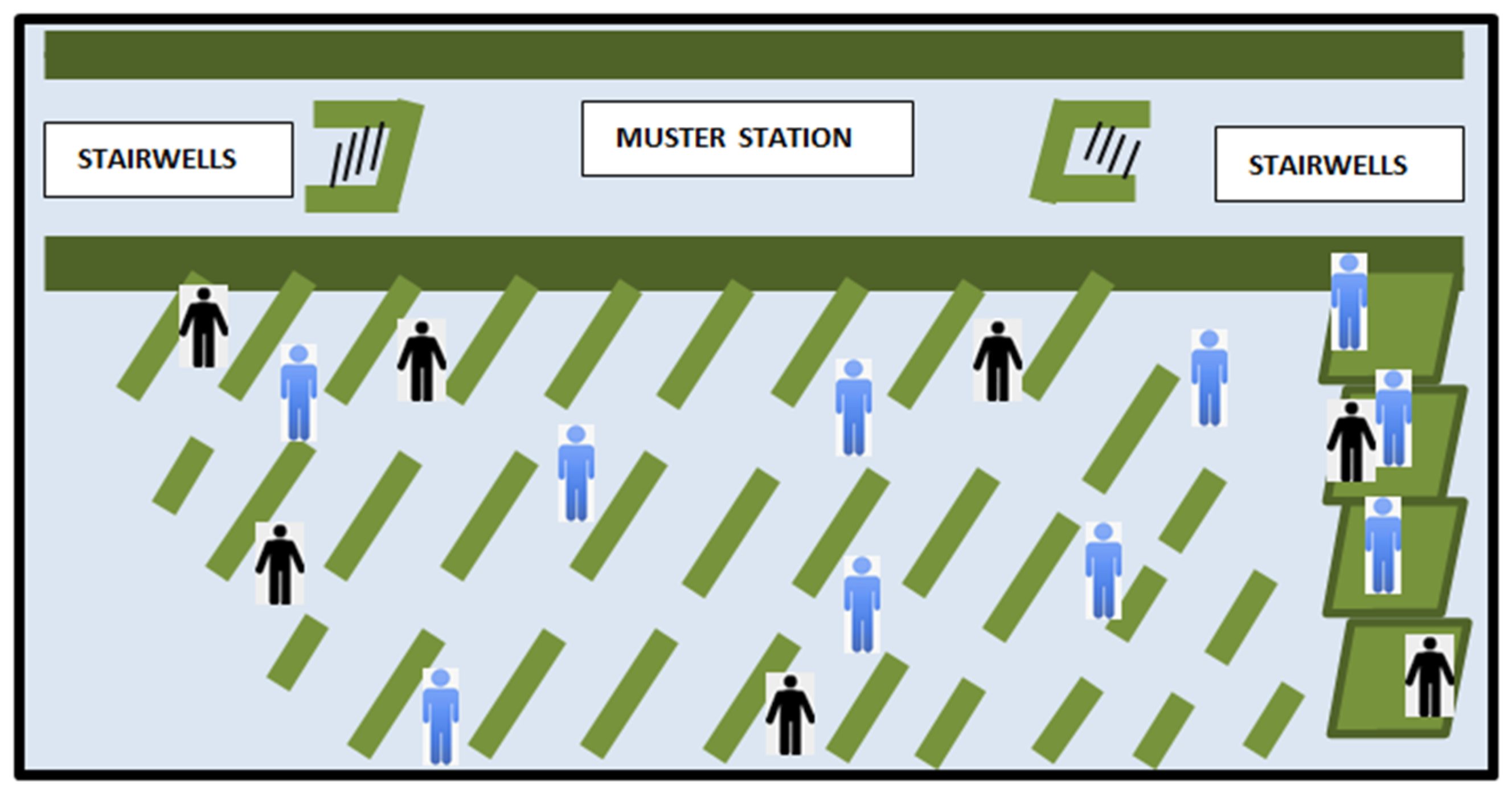
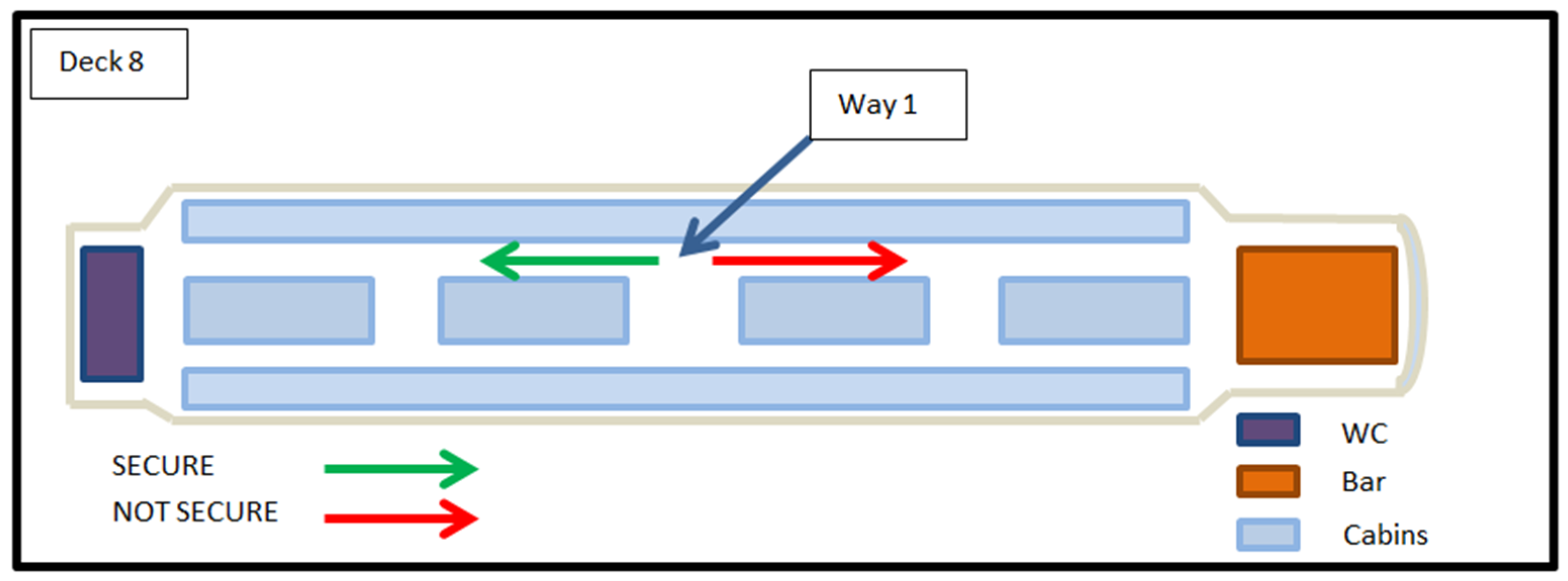
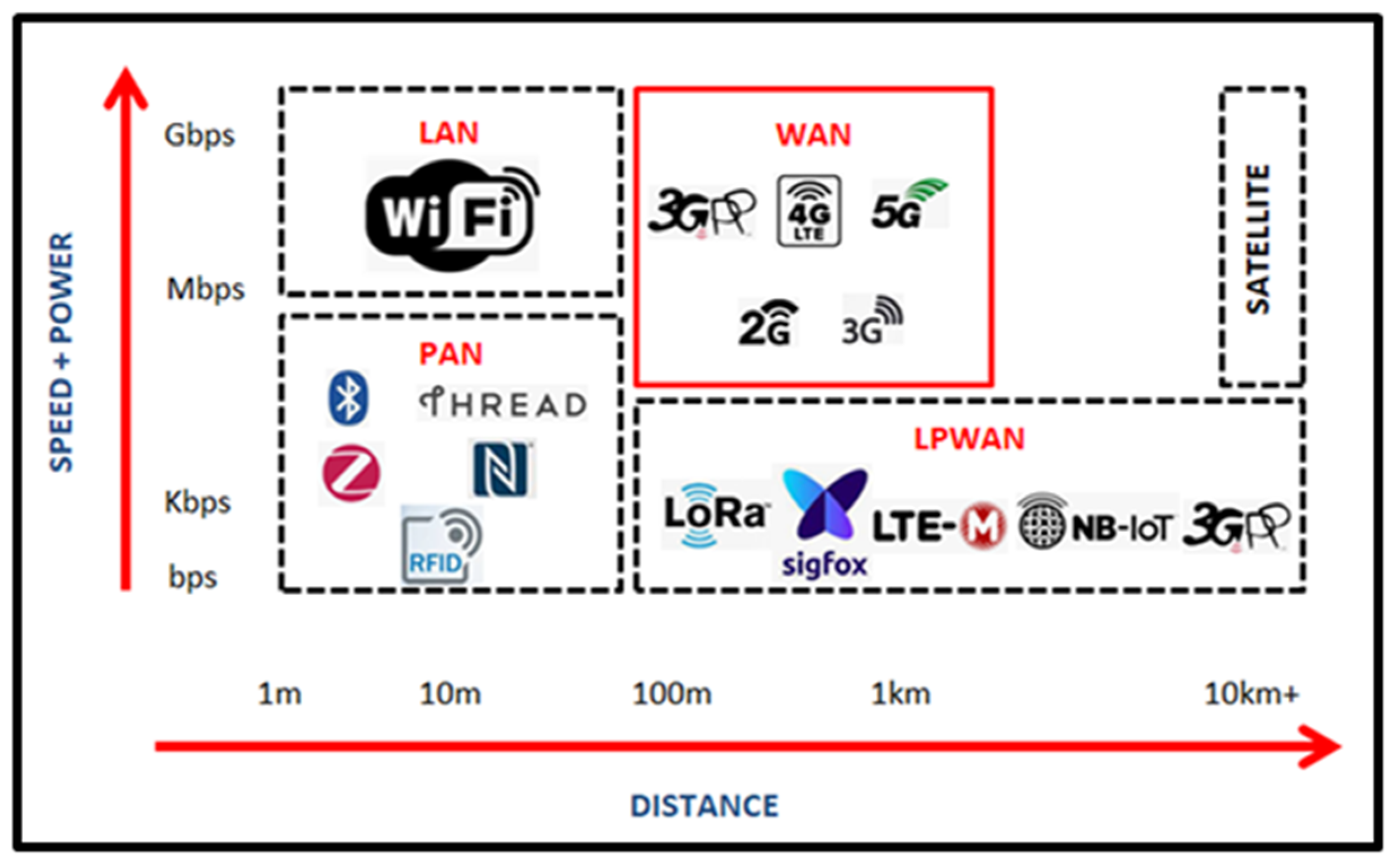
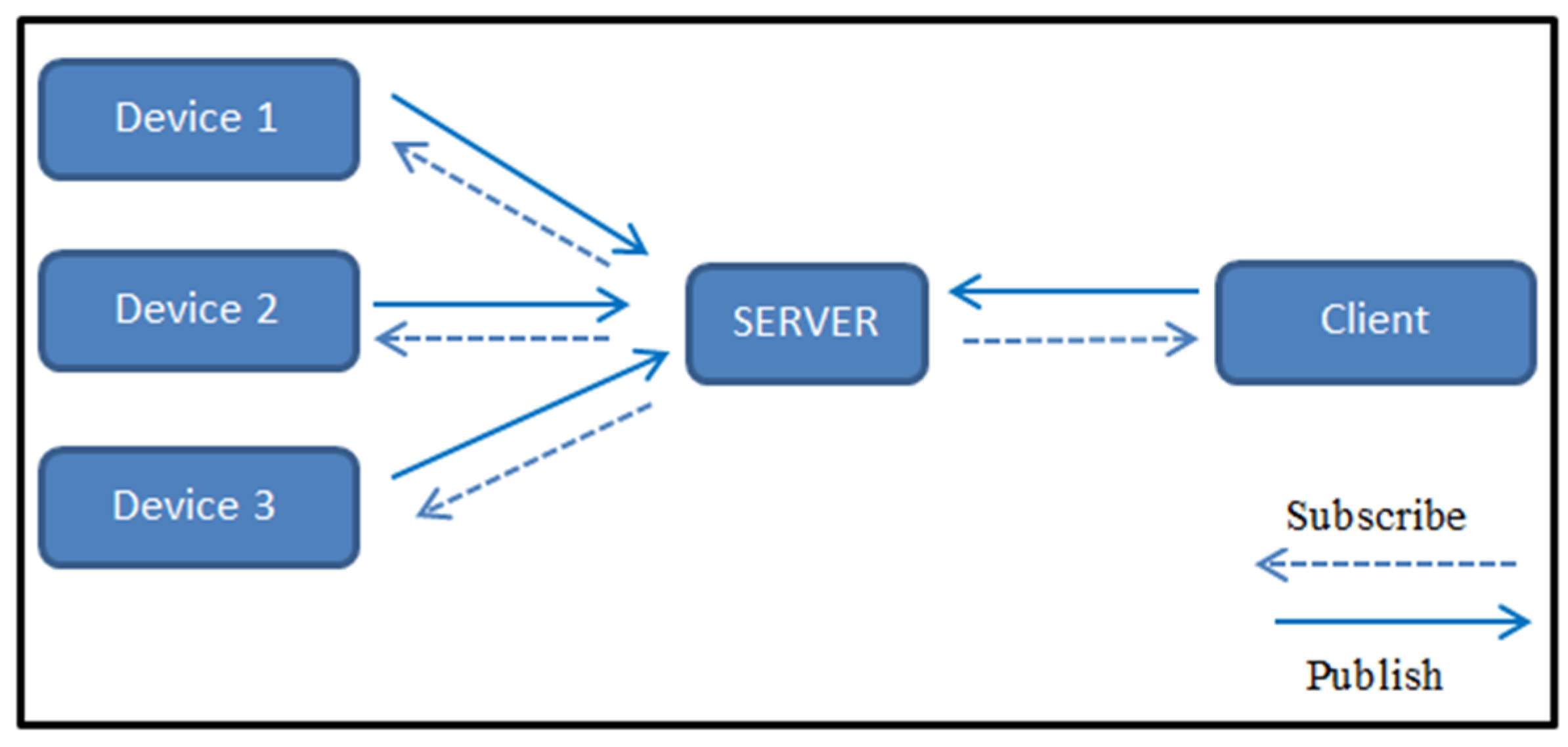
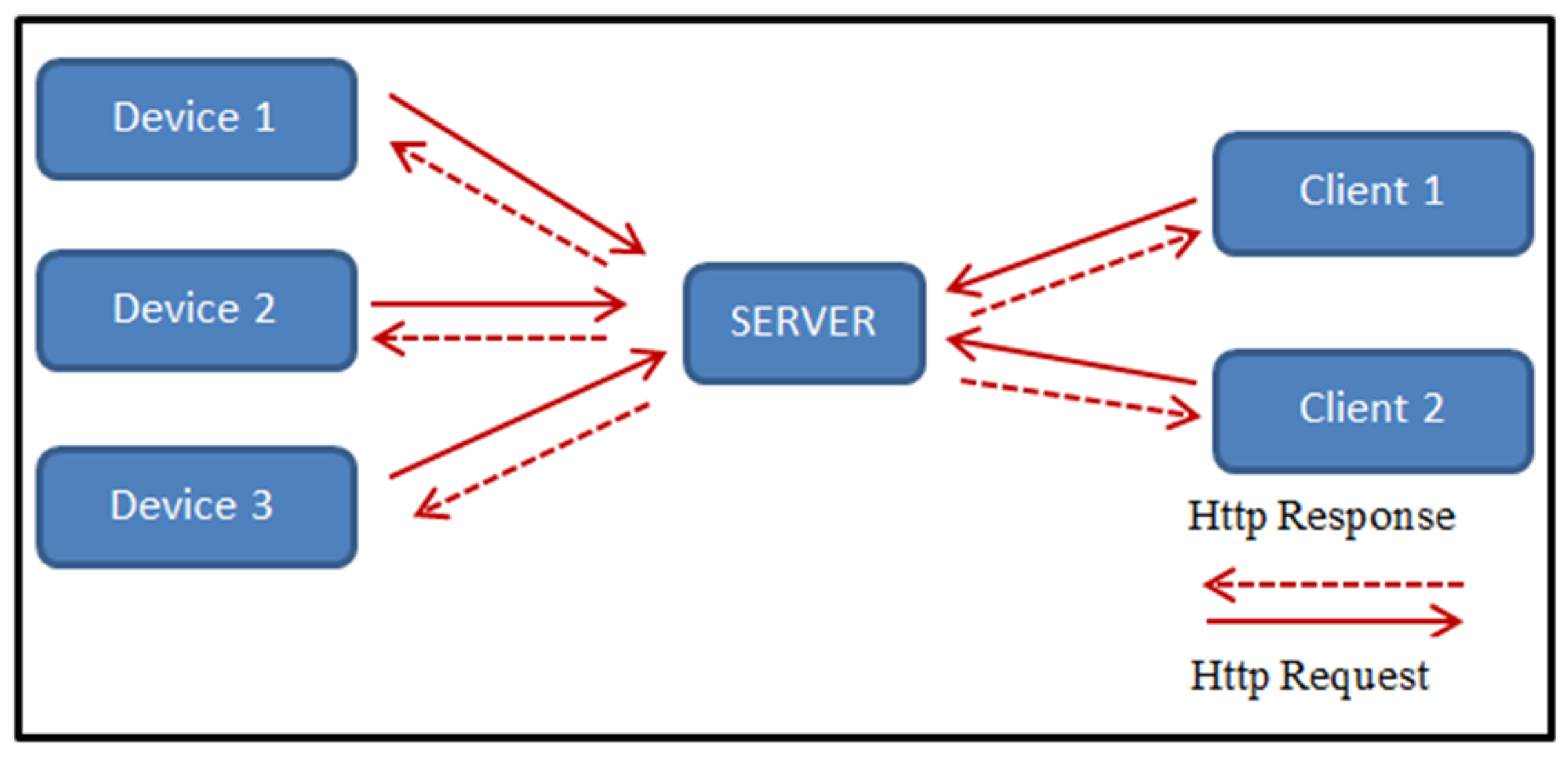
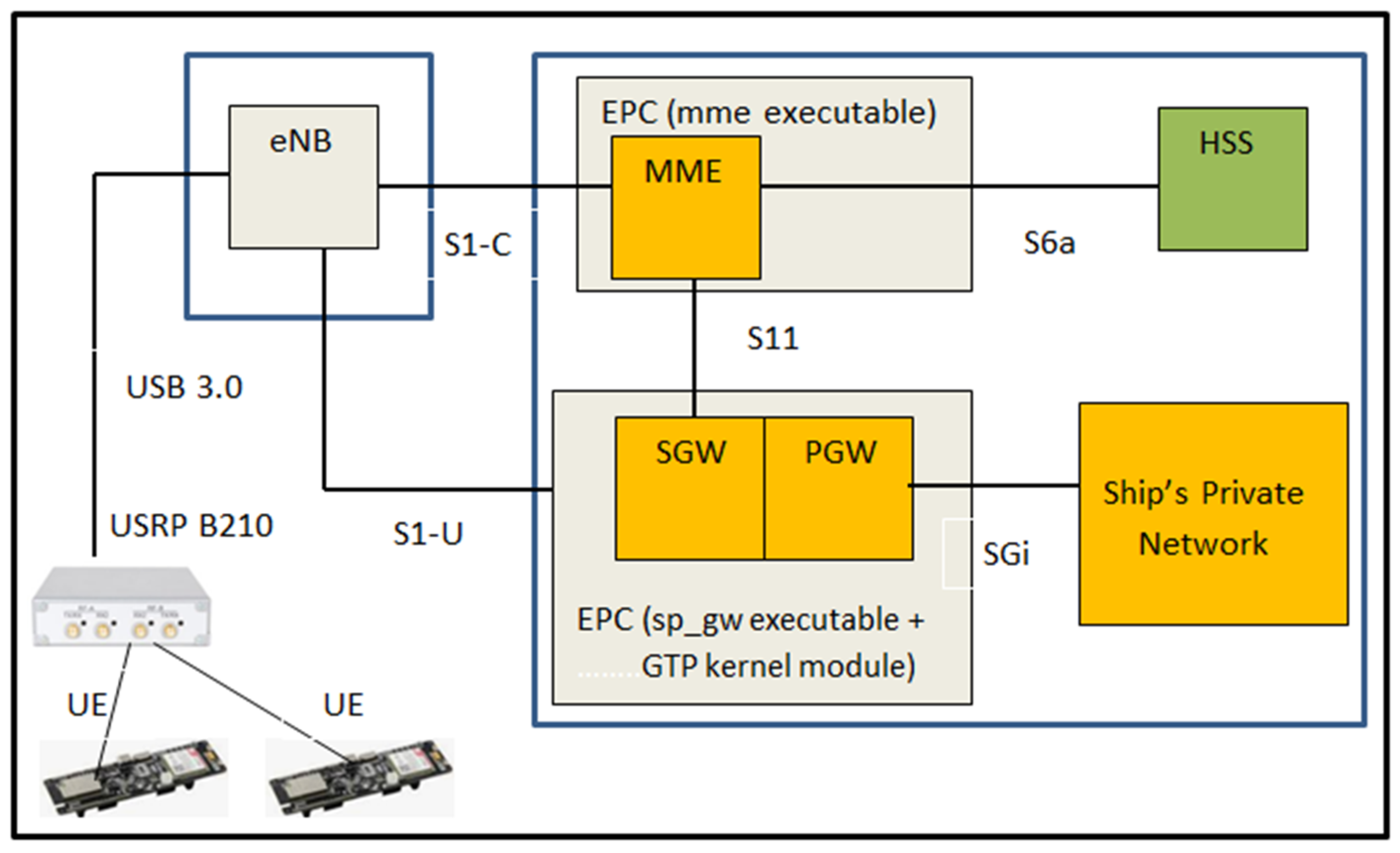

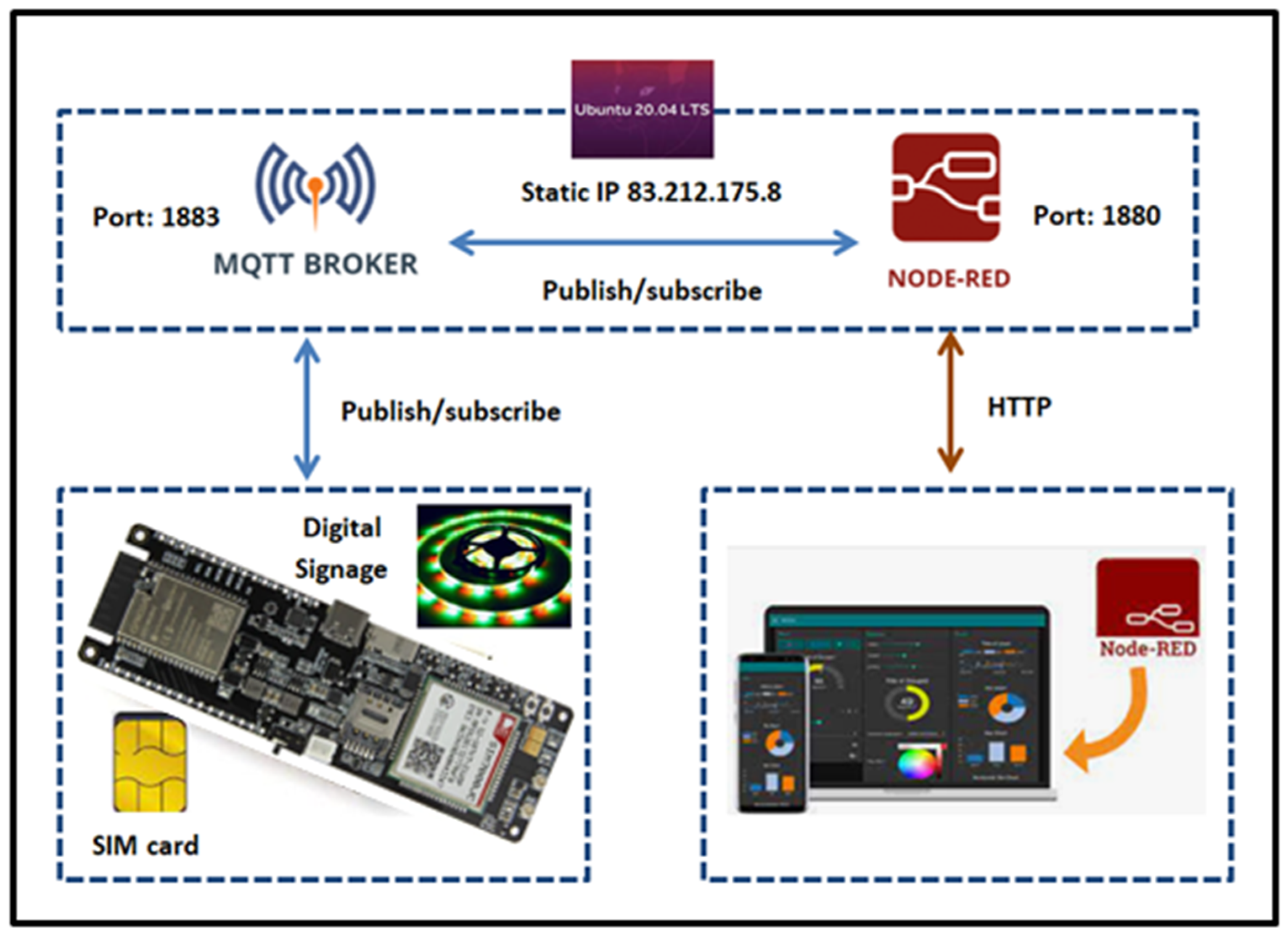
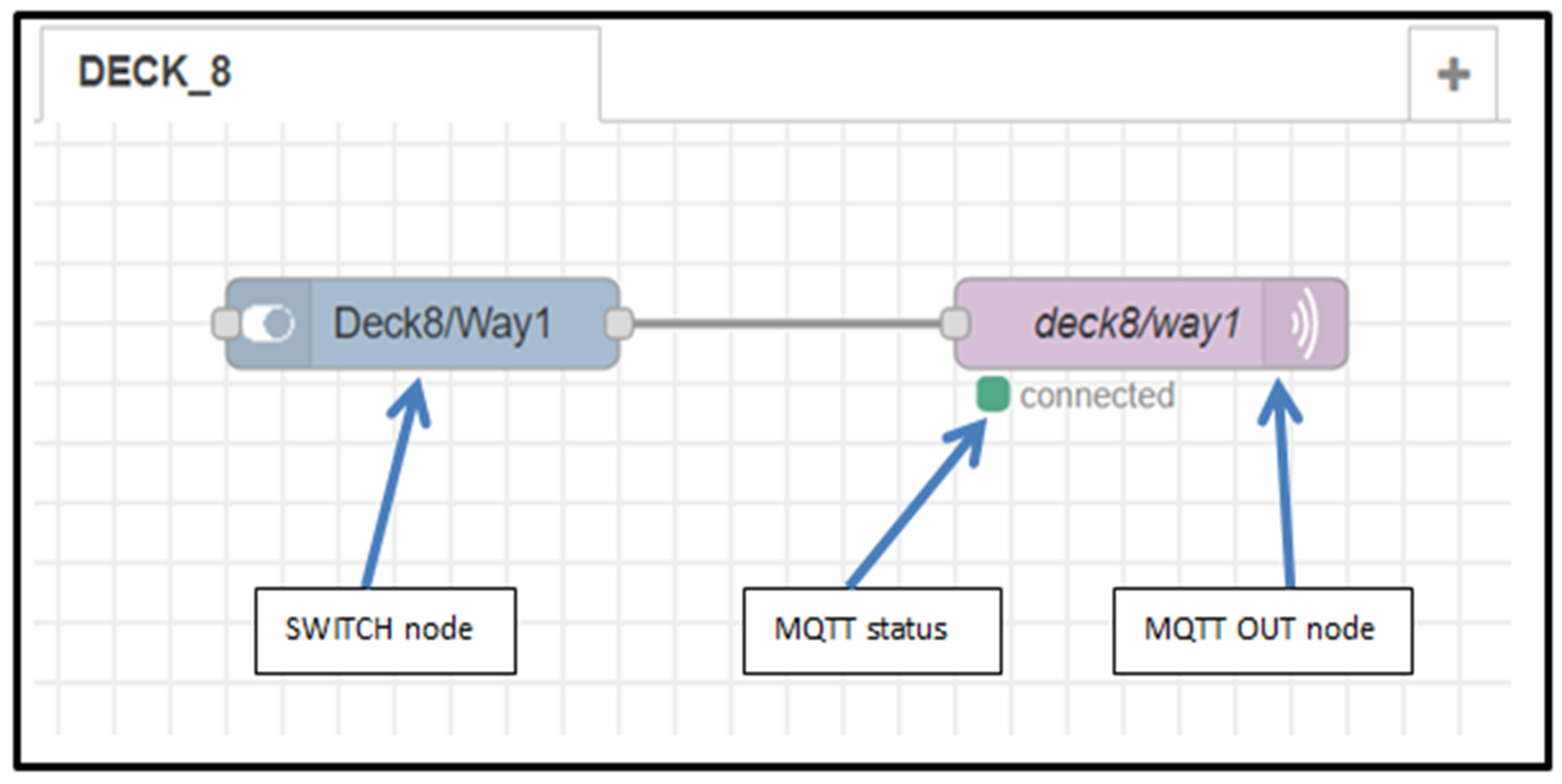

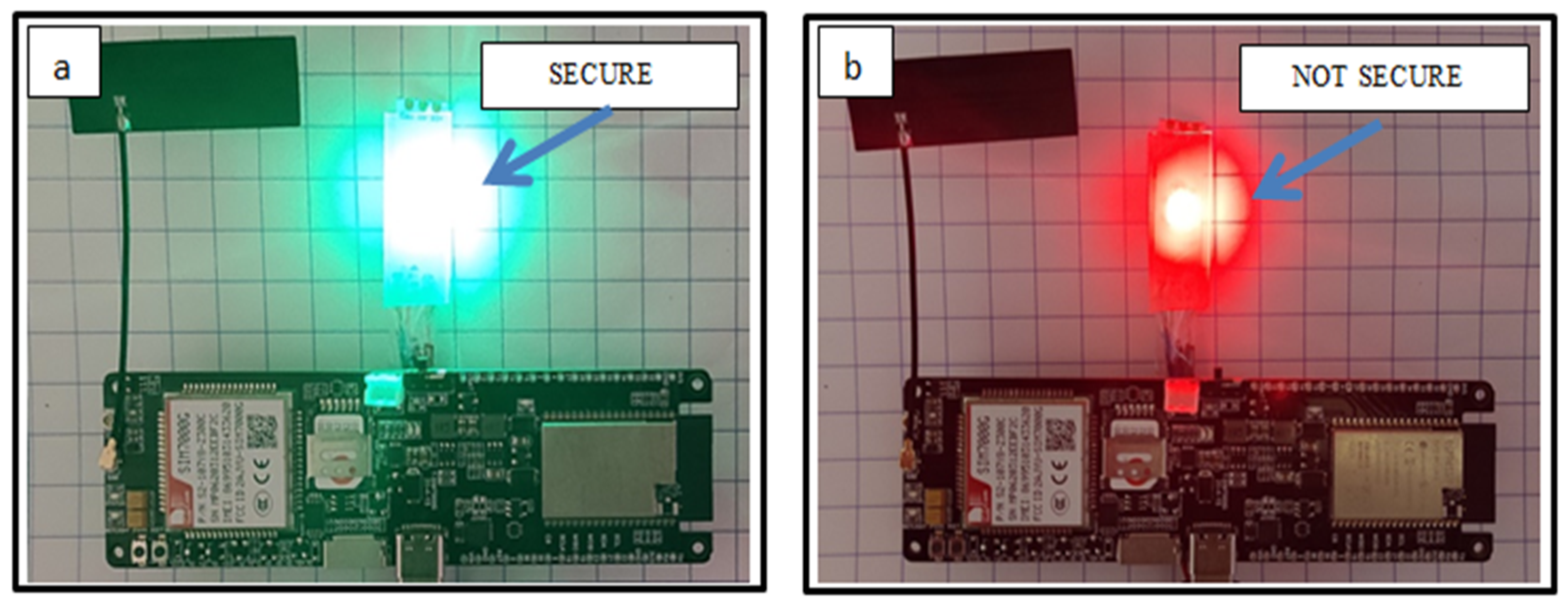
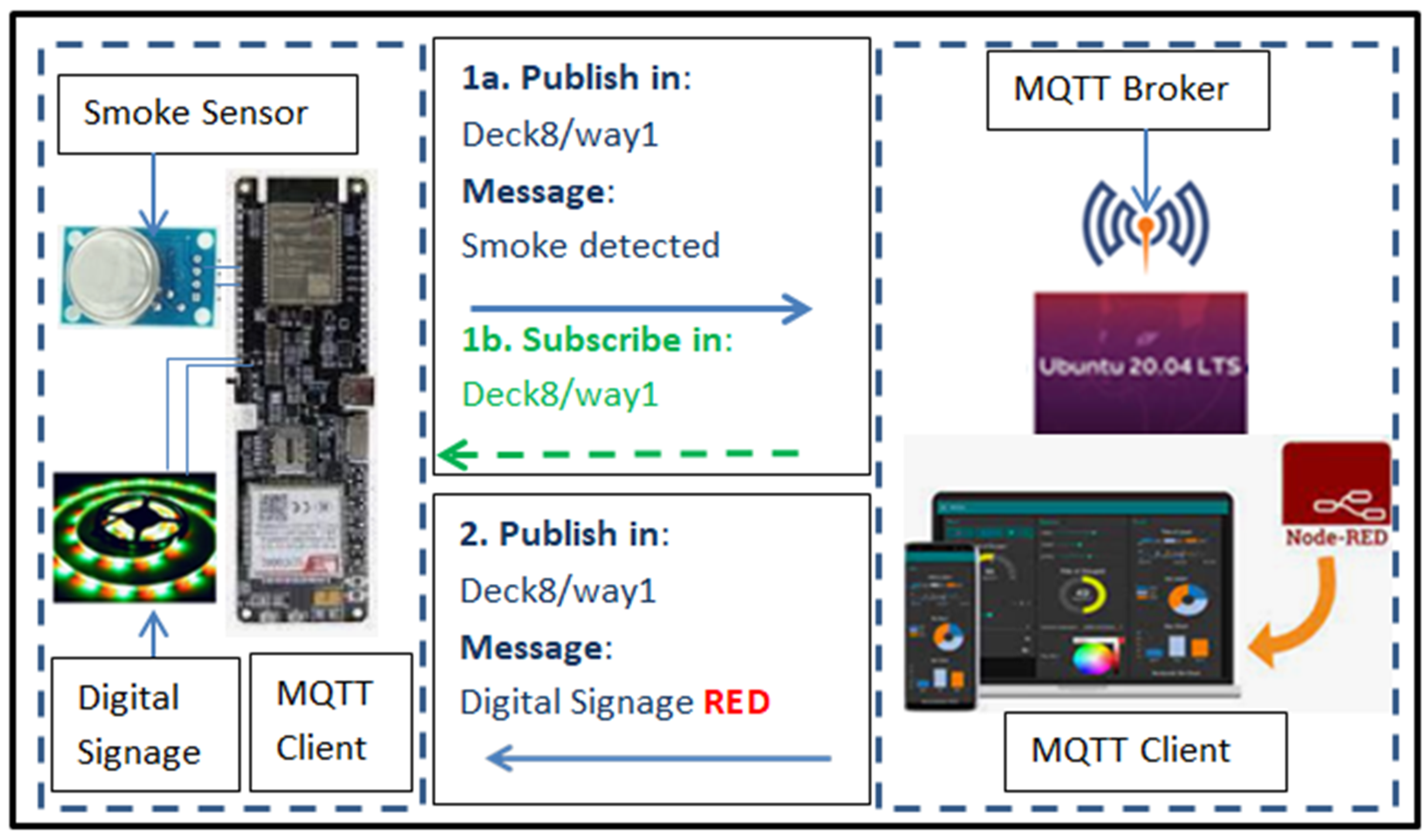
| PAN | WLAN | LPWAN | Cellular WAN | ||||||
|---|---|---|---|---|---|---|---|---|---|
| BLUETOOTH | ZIGBEE | WIFI | SIGFOX | LoRa | NB-IoT | GSM | LTE-M | 5 G (Targets) | |
| Coverage Area | 1–10 m | 1–100 m | 17–30+ m | <12 km (160 db) | <10 km (157 db) | <15 km (164 db) | <15 km (164 db) | <10 km (156 db) | <12 km (160 db) |
| Spectrum Bandwidth | 2.4 GHz (802.15.1) | 2.4 GHz (802.15.4) | 2.4 GHz (802.11) | Unlicensed 900 MHz 100 kHz | Unlicensed 433, 868, 915 MHz <500 kHz | Licensed 7–900 MHz 200 kHz shared | Licensed 800, 900 MHz shared | Licensed 700, 900 MHz 1.4 MHz shared | Licensed 700, 900 MHz shared |
| Data Rate | 1 Mbps | 250 kbps | 150 Mbps | <100 kbps | <10 kbps | <50 kbps | 10 kbps | <1 Mbps | <1 Mbps |
| Terminal Cost | 4.00 $ | 3.00 $ | 4.00 $ | 2.64 $ | 2.64 $ | 2–3 $ | 2.97 $ | 3.30 $ | <2 $ |
| Network Reforming | None | None | None | Large | Large | Small to moderate | Moderate (LTE reuse) | Small | Requires 5 G NWs |
| Payload Size (kb) | 0–200 | 200–400 | 400–600 | 600–800 | 800–1000 | 1000–1200 |
|---|---|---|---|---|---|---|
| QoS 0 PT (ms) | 1.9575 | 3.3773 | 4.4756 | 5.9152 | 7.1644 | 7.6543 |
| QoS 0 TLS (ms) | 1.9738 | 3.8433 | 5.3904 | 7.5574 | 9.9594 | 11.8360 |
| QoS 0 TLSMA (ms) | 1.9233 | 3.5789 | 5.4169 | 7.0627 | 9.7204 | 11.7716 |
| QoS 1 PT (ms) | 1.8276 | 2.8415 | 3.6975 | 5.1162 | 6.8120 | 7.8951 |
| QoS 1 TLS (ms) | 1.9451 | 3.5139 | 5.5778 | 7.9114 | 10.187 | 11.8742 |
| QoS 1 TLSMA (ms) | 1.7534 | 3.0070 | 4.4488 | 6.8328 | 9.9884 | 11.7456 |
| QoS 2 PT (ms) | 2.8024 | 3.8195 | 4.5763 | 6.1935 | 7.6070 | 8.2785 |
| QoS 2 TLS (ms) | 2.5047 | 3.7768 | 5.3041 | 7.9585 | 11.425 | 12.8641 |
| QoS 2 TLSMA (ms) | 2.4494 | 3.7117 | 5.2145 | 7.7037 | 10.6853 | 12.0606 |
| ACRONYM | ABBREVIATION |
|---|---|
| eNB | Evolved Node B |
| EPC | Evolved Packet Core |
| EUTRAN | Evolved Terrestrial Radio Access Network |
| HSS | Home Subscriber Server |
| MME | Mobility Management Entity |
| OAI | Open Air Interface |
| PGW | Packet Data Network Gateway |
| SGW | Serving Gateway |
| UE | User Equipment |
| S1-C,S1-U,S11,S6a,SGi | Communication Protocols |
| PRODUCT | SIM7000G | |
|---|---|---|
| Form Factor | LCC, 68PIN | |
| Dimensions (mm) | 24X24X2.6 | |
| Frequency Bands | Cat-M | B1/B2/B3/B4/B5/B6/B8/B12/B13/B17/B18/B19/B20/B25/B26/B28/B39 |
| Cat-NB | B1/B2/B3/B4/B5/B6/B8/B12/B13/B17/B18/B19/B20/B25/B26/B28 | |
| GSM | 850/900/1800/1900MHz | |
| Temperature GNSS | −40 oC~+85 oC optional | |
| ELECTRICAL FEATURES | ||
| Supply Voltage Range (V) | 3.0~4.3 | |
| Power Consumption | Power Off (uA) | 7 |
| PSM (uA) | 9 | |
| Sleep (mA) | 1 | |
| Idle (mA) | 11 | |
| DATA TRANSFER | ||
| Cat-M (Kbps) | 300(DL)/375(UL) | |
| Cat-NB (Kbps) | 34(DL)/66(UL) | |
| EGPRS (Kbps) | 85.6(DL)/85.6(UL) | |
| SOFTWARE FEATURES | ||
| Protocol | TCP/UDP/LWM2M/COAP/MQTT/FTP/HTPP/TLS/DTLS/NTP | |
| FOTA | ● | |
| Embedded AT | ● | |
| Firmware Upgrade | USB/FOTA | |
| INTERFACES | ||
| SIM Card | 1.8 V/3.0 V | |
| UART | ● | |
| USB | ● | |
| PCM | ● | |
| ADC | ● | |
| I2C | ● | |
| CERTFICATION | ||
| Regulatory | RoHS/REACH/CCC/CE(RED)/GCF/Deutsche Telekom/FCC/IC/OCD(Anatel) | |
| Carrier | Deutsche Telekom/ORANGE/PTCRB | |
Publisher’s Note: MDPI stays neutral with regard to jurisdictional claims in published maps and institutional affiliations. |
© 2022 by the authors. Licensee MDPI, Basel, Switzerland. This article is an open access article distributed under the terms and conditions of the Creative Commons Attribution (CC BY) license (https://creativecommons.org/licenses/by/4.0/).
Share and Cite
Cheimaras, V.; Trigkas, A.; Papageorgas, P.; Piromalis, D.; Sofianopoulos, E. A Low-Cost Open-Source Architecture for a Digital Signage Emergency Evacuation System for Cruise Ships, Based on IoT and LTE/4G Technologies. Future Internet 2022, 14, 366. https://doi.org/10.3390/fi14120366
Cheimaras V, Trigkas A, Papageorgas P, Piromalis D, Sofianopoulos E. A Low-Cost Open-Source Architecture for a Digital Signage Emergency Evacuation System for Cruise Ships, Based on IoT and LTE/4G Technologies. Future Internet. 2022; 14(12):366. https://doi.org/10.3390/fi14120366
Chicago/Turabian StyleCheimaras, Vasileios, Athanasios Trigkas, Panagiotis Papageorgas, Dimitrios Piromalis, and Emmanouil Sofianopoulos. 2022. "A Low-Cost Open-Source Architecture for a Digital Signage Emergency Evacuation System for Cruise Ships, Based on IoT and LTE/4G Technologies" Future Internet 14, no. 12: 366. https://doi.org/10.3390/fi14120366
APA StyleCheimaras, V., Trigkas, A., Papageorgas, P., Piromalis, D., & Sofianopoulos, E. (2022). A Low-Cost Open-Source Architecture for a Digital Signage Emergency Evacuation System for Cruise Ships, Based on IoT and LTE/4G Technologies. Future Internet, 14(12), 366. https://doi.org/10.3390/fi14120366











